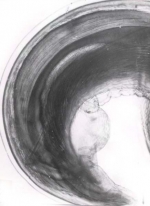NEIHPID
North-East India Helminth Parasite Information Database
Recently added
Parasites
Molecular Data
Ascarops dentata (Alicata et McIntosh Alicata et McIntosh) Linstow 1904
Taxonomy
Nematoda »
SECERNENTEA »
Spirocercidae (Chitwood et Wehr, 1934) Chabaud, 1975 »
Ascaropsinae Alicata et McIntosh, 1933 »
Ascarops Beneden, 1873 »
Ascarops dentata (Linstow 1904), Alicata et McIntosh 1933
Synonyms
(Spiroptera dentata Linstow, 1904)
Host
Sus (scrofa domestica)
Habitat
Small intestine
Locality
Shillong (Meghalaya), Nongstoin (Meghalaya)
Description
General
Relatively small sized worms. Cervical ala present only at left side of body, begins at short distance from anterior extremity. Cervical papillae placed asymmetrically. Pharynx cylindrical containing several spiral rows of cuticular thickenings, guarded at its entrance by dorsal and ventral tooth. Oesophagus long, consisting of two parts, anterior much shorter.
Male
Body 20.0-25.0 mm in length, 0.70-0.82 mm in maximum width. Tail coiled, with asymmetrical alae. Ventral surface of tail and caudal alae possessing several longitudinal rows of elongated cuticular thickenings. Caudal papillae five pairs with relatively small peduncles, of these four pairs pre-anal, asymmetrical; one pair post-anal symmetrical; additionally five pairs of small, asymmetrical sessile papillae present between last pair of pedunculate papillae and tip of tail. Cloacal aperture surrounded by somewhat triangular elevated structure, latter with serrated margin at right side. Spicules dissimilar, left long; right short, stout.
Female
Body 25.0- 38.0 mm in length, 0.93-1.08 mm in maximum width. Tail short, conical, curved dorsally. Vulva not so distinct, opening far behind middle of body. Eggs elliptical, thick shelled, containing coiled larva inside, 0.034-0.038 x 0.019-0.022 mm.
Remarks
A. dentata closely resembles A. stronqylina in general appearance. The length of the body could differentiate these two species; however, the width of the body, pharynx and tail and also the length of the spicule (relatively more in A.dentata) could be taken as supporting characters in the differentiation of the two species. Besides, in males of A. dentata the triangular elevation present surrounding the cloaca appears to be less prominent than that in A. stronqylina.
Helminthological collections record
NEHU/Z - NM/8



.jpg)
